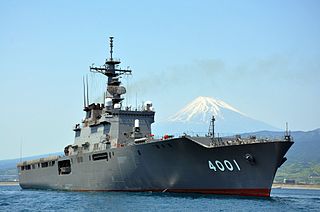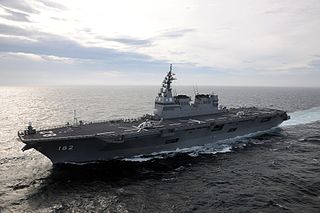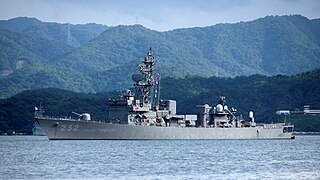Construction and career
Tone was laid down at Sumitomo Heavy Industries Tokyo Shipyard on 8 February 1991 and launched on 6 December 1991. She was commissioned on 8 February 1993 and deployed to Sasebo. [2]
From 2–4 August 1999, Tone visited Busan, South Korea with the escort vessels JS Shirane and JS Setoyuki, and conducted the first Japan-Korea joint training in the East China Sea from the 4–5 August.
It was planned for the destroyer escort to be open to the public at Shibushi Port along with the escort vessels JS Sendai, JS Sawakaze, and the transport vessel JS Ōsumi at the Kanoya Air Festival held from 19 to 20 May 2001, but Fukuejima a Chinese Navy's ice-breaking information gathering ship sailing offshore was canceled due to tracking and monitoring. After leaving Sasebo on 2 October, the same year, she engaged in warning and surveillance activities for the US Navy amphibious assault ship USS Essex.
Around 5:30 pm on 16 February 2016, the Chinese Navy's East Sea Fleet sailed 85 kilometres (53 mi) east-northeast of Taneshima from the Pacific Ocean to the East China Sea. The frigate Yantai, spy ship Tianlangxing and supply ship Honghu were discovered together by P-3C aircraft belonging to the 5th Air Group and the support ship JS Genkai. [3] After that, four ships were spotted heading west through the Ōsumi Strait. On 25 December, the Joint Staff Office of the Ministry of Defense announced that Tone was in the waters of the central East China Sea at around 4 pm on the 24th of the same month, with the Chinese Navy aircraft carrier Liaoning, three missile destroyers and three frigate ships, and one supply ship, visually confirming the aircraft carrier's presence. This is the first time that the Maritime Self-Defense Force has visually confirmed the aircraft carrier of the Chinese Navy. [4]

The Japan Maritime Self-Defense Force, abbreviated JMSDF, also simply known as the Japanese Navy, is the maritime warfare branch of the Japan Self-Defense Forces, tasked with the naval defense of Japan. The JMSDF was formed following the dissolution of the Imperial Japanese Navy (IJN) after World War II. The JMSDF has a fleet of 154 ships, 346 aircraft and 50,800 personnel.

JS Ōsumi (LST-4001) is the lead ship of the Ōsumi-class tank landing ships of the Japan Maritime Self-Defense Force (JMSDF).

JS Hyūga (DDH-181) is the lead ship of the Hyūga-class helicopter destroyers of the Japan Maritime Self-Defense Force (JMSDF).

JS Ise (DDH-182) is a Hyūga-class helicopter destroyer of the Japan Maritime Self-Defense Force (JMSDF). It is the second ship to be named Ise, the first being the Imperial Japanese Navy World War II-era battleship Ise.

JS Mineyuki (DD-124) was a Hatsuyuki-class destroyer of the Japanese Maritime Self-Defense Force.
JS Harusame (DD-102) is the second ship of Murasame-class destroyers. She was commissioned on 24 March 1997.

JS Samidare (DD-106) is the sixth Murasame-class destroyer of the Japan Maritime Self-Defense Force (JMSDF). She was commissioned on 21 March 2000.

JS Umigiri (DD-158) is an Asagiri-class destroyer of the Japan Maritime Self-Defense Force.

JS Sawagiri (DD-157) is an Asagiri-class destroyer of the Japan Maritime Self-Defense Force.

JS Haruyuki (DD-128) was a Hatsuyuki-class destroyer of the Japanese Maritime Self-Defense Force.

JS Asayuki (DD-132) was a Hatsuyuki-class destroyer of the Japanese Maritime Self-Defense Force.

JS Shimayuki (DD-133/TV-3513) was a Hatsuyuki-class destroyer of the Japanese Maritime Self-Defense Force.

JS Abukuma (DE-229) is the lead ship of the Abukuma-class destroyer escorts. She was commissioned on 12 December 1989.

JS Ōyodo (DE-231) is the third ship of the Abukuma-class destroyer escorts. She was commissioned on 23 January 1991.

JS Sendai (DE-232) is the fourth ship of the Abukuma-class destroyer escorts. She was commissioned on 26 January 1990.

OPS-14 is a two-dimensional radar manufactured by Mitsubishi Electric. It is mainly mounted on the Maritime Self-Defense Force's self-defense ship as an anti-aircraft search radar. Variations include OPS-14B and OPS-14C.

OPS-28 is a Pulse-Doppler radar manufactured by Japan Radio. It is installed as a low-altitude warning / anti-water search radar mainly on the Maritime Self-Defense Force's escort ship. Variations include OPS-28-1, OPS-28B, OPS-28C, OPS-28D, OPS-28E and OPS-28F.

The Fleet Escort Force is the main force of the Self Defense Fleet of the Japan Maritime Self-Defense Force, and played a central role in the Maritime Self-Defense Force, which mainly consists of escort vessels and various other ships. Together with the Fleet Submarine Force, Mine Warfare Force, and Fleet Air Force, it is responsible for Japan's maritime defense.

The Safety Security Force, also known as the Coastal Security Force, was an organization under the jurisdiction of the National Safety Agency, and existed from 1 August 1952 to 30 June 1954 in Japan. It was a maritime security agency established for the purpose of territorial waters security. It was the successor to the Maritime Safety Agency and the predecessor of the Maritime Self-Defense Force.
The Sasebo Naval Base, also simply known as the JMSDF Sasebo Naval Base, is a group of ports and land facilities of the Japan Maritime Self-Defense Force (JMSDF), which are scattered in multiple districts of Sasebo City, Kyushu, and where the Sasebo District Force are located.
This page is based on this
Wikipedia article Text is available under the
CC BY-SA 4.0 license; additional terms may apply.
Images, videos and audio are available under their respective licenses.





















